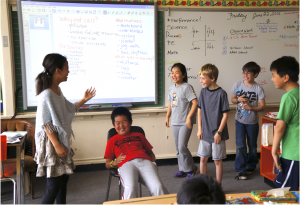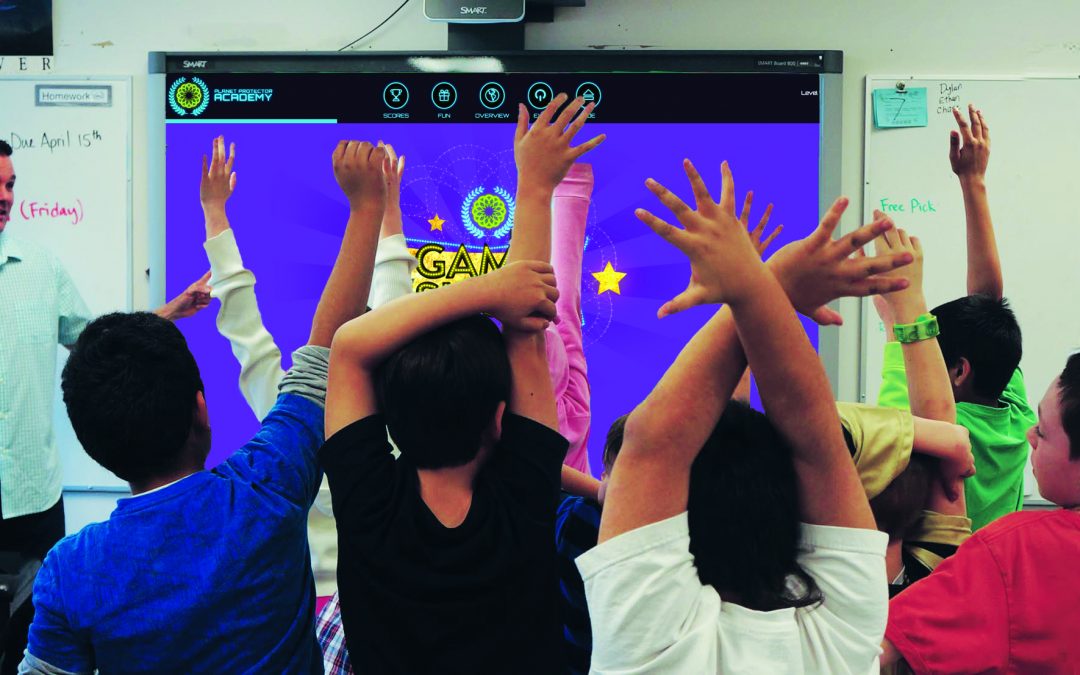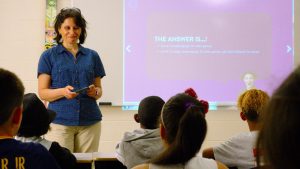By. Vanessa LeBourdais, Executive Producer and Creative Director, DreamRider Productions
These days, those of us who care about the well-being of children can be deeply concerned about the effects of technology. It can seem like tech does not have a place in environmental education when students are already struggling with screen addictions. Doesn’t tech just disconnect children from each other and from the world around them, we wonder? How can it possibly be used in environmental education when the whole point is connecting students with nature?
However, technology is still just a tool that can be used for good or bad. So, is it possible to use this tool to further environmental education goals? What can it uniquely accomplish?
I became an accidental edu-tech innovator. I don’t play video games or have a technology background. I’m a theatre major and the Executive Director of an environmental education theatre company, DreamRider Productions. Somehow, and maybe because of that, I have led the creation of an educational technology that does not do what most tech does. Instead of addicting kids to a screen, we used those same engagement and motivational powers to get kids off the screen, using their bodies in the classroom, collaborating together, and then going out and changing the world.
This article shares five core principles that we learned during the development of our digital-led teaching resource, Planet Protector Academy. These principles helped us see how technology can serve environmental education by boosting student engagement, creating change in the real world, and scaling environmental literacy efforts.
Core Principle #1: Make It an Experience
For twenty years at DreamRider our live shows had been deeply engaging kids in a full-bodied, interactive way. Kids watching our shows would sing along, call out answers, and be almost jumping in their seats. Our first experiment in digital was to make stand-alone educational videos. But as we observed students watching them, we noted their glazed eyes and motionless bodies.
In the end, we realized it all comes down to creating an experience. The critical “technology” we are using is our motivational power as writers. To design our tech – what eventually became Planet Protector Academy – we first ignored tech altogether and used our theatre training to experiment and improvise in-person in the classroom.
We created a six-part experience that kids would go through in the classroom – as ‘apprentices’ in a real-life superhero Academy – and tweaked it until it worked. That is, until kids felt like real-life Planet Protectors and were super-excited to go home on their weekly missions. We were thrilled when parents reported how students were applying their learning and changing their families’ environmental behaviours at home – saving energy, saving water, even driving less.

Early classroom testing of the Planet Protector Academy, using a whiteboard to keep score and track student answers. (Photo: Vanessa LeBourdais)
We talked to teachers, we talked to kids, we talked to parents, and we kept iterating. Finally, we replaced ourselves in the classroom with our superhero characters on-screen – videos projected by the teacher at the front of the class, leading the offline activities and experiences we had devised. We hosted the videos on an interactive website and added a scoreboard to track students’ points and on-screen instructions to guide the class through each lesson. Even without us there, they sang, they yelled with excitement, their whole bodies were engaged and involved. Six years since the program went fully digital, students have gone home to change their families’ behaviours in 125 cities and counting!
The essential technology was the design of the engaging experience. The digital technology was merely the tool to facilitate that experience in our absence.
Core Principle #2: Design from the Perspective of the Student
Make it a game. Gamification is a key part of most tech that kids love, is fairly simple to implement, and will also serve classroom management.[1] Michele Reid, a VP in Port Coquitlam, British Columbia, found this to be true: “You have no idea how much the teams and points helps classroom management!” Michele says. “We will be staying in teams all year!” This approach has also been successfully used by the edtech tool Classcraft, which helps teachers gamify any subject matter.
Consider all learning styles. Think of kids who are primarily physical (physical games), mental (math), visual (drawing), emotional (theatre skit), introverted (solo activities), extroverted (group activities), diverse cultures (representation online), etc. These multiple intelligences come together when we teach environmental literacy, but that can also present a challenge. San Francisco grade three teacher Jody Frandle told us how she struggled to engage all her students in her environmental education efforts. “The multiple ways of engaging students – song, game show, drawing, and watching videos – are so helpful in keeping their attention,” she reports.
Core Principle #3: Use Technology to Relieve Teachers
Feedback from teachers and administrators showed us that it was not enough for the program to be fun for students and cover necessary curriculum. We needed to use technology to find ways to ease teachers’ workloads and offer an alternative to the sometimes-prohibitive prep involved with PDF-based resources. We spent as much time thinking about the learning curve for teachers to use the resource as we did about the learning curve for students. Ultimately, we knew that uptake of the resource depended on it being user-friendly not only to tech-savvy teachers, but also to those who are more tech-fearful.
Core Principle #4: Use Technology to Give Educators Superpowers
Elementary grade teachers come to the classroom with varied levels of knowledge, skills, and confidence across the subject areas they must teach, especially those related to environmental education. They are also teaching under time, money, and resource constraints that can affect the quality of the learning environment for students. Technology-assisted environmental education can help to overcome some of these challenges by augmenting and amplifying effective learning strategies – what we like to think of as giving teachers superpowers to help them do more in the classroom.
We initially developed Planet Protector Academy in-person but ensured that the activities we developed were child-centered and would travel well across different teaching and geographic contexts. The role of the technology then was to package this immersive experience into a plug and play resource to be used by any teacher anywhere. Teachers are effectively bringing the Academy to their classroom each time they use it (costumes and wigs are optional!) but it plays out differently each time. “Just press play and it runs itself,” says grade 3/4 teacher Shane Hipwell in Abbotsford, British Columbia. “You get to ride along with the class and it’s so much fun!” By using technology to facilitate learning environments in this way, teachers who are less confident teaching scientific concepts, environmental curricula, or arts-based activities can still provide interdisciplinary learning opportunities for their students and develop confidence in new skills and approaches.
Technology is also inherently engaging for students, especially diverse learners. This can reduce a teacher’s workload as well as effectively engage students who otherwise have significant barriers. A grade 4/5 teacher named Jennifer (last name and location withheld by request for the privacy of the child) tells of using our tech in her class, in which one student was only able to manage one half-day a week at school and was attending a support program. Jennifer says that the engaging nature of the technology helped connect the student to the environmental content, while “being part of a team and working towards a common goal helped this student feel good about himself and feel appreciated by his peers during a very difficult time in his life,” Jennifer says.
Core Principle #5: Use Technology to Overcome Access and Equity Issues
Beyond the engaging experience for students, technology-based resources can help stretched sustainability and curriculum coordinators provide more environmental literacy learning opportunities across their districts.
Teachers who are less familiar with sustainability topics can find an easy entry into the topic outside of formal professional development workshops – and increase their own sustainability knowledge at the same time, as 88% of teachers who have used our resource have reported doing.
Technology can also dissolve access barriers across school districts: “It was a great way to reach a wide amount of students both rural and urban in such a geographically large school board,” said Dan Hendry, Sustainable Initiatives Coordinator at Limestone District School Board. It does not need to be high tech either – our culture’s obsession with new and shiny overlooks simple low-tech solutions (think projector and laptop vs. AR/VR) that avoid creating additional financial or equipment barriers for schools with fewer resources.
In summary, while many uses of technology encourage addiction and disconnection from each other and the world around us, this does not have to be the case. By using these five core principles, technology can be an enabler, connector, and equalizer. It can be harnessed to do tremendous good – for students, teachers, and environmental literacy as a whole.
Author Bio
Vanessa LeBourdais is the Executive Producer of the environmental engagement charity DreamRider Productions, which has reached almost a million students with its engaging live and digital programs. Vanessa created DreamRider’s digital resource PlanetProtectorAcademy.com which has transformed kids in 125 cities across Canada and the U.S. into real-life superheroes. Awards include the TELUS Innovation Award, Canada’s Earth Day’s Top Ten Heroes Award, and Recycling Council of British Columbia’s Nonprofit Award. Vanessa drove a successful online equity initiative in the 35,000-member Facebook group, Nonprofit Happy Hour. She also was an organizer of the biggest civil disobedience action in Canadian history, in Clayoquot Sound, British Columbia.
[1] For more information on using story, arts, and gamification in environmental learning, see my two articles in Green Teacher magazine.
Using gamification: “Let the Games Begin!”
Using Arts & Story: “Planet Protecting Superheroes”


